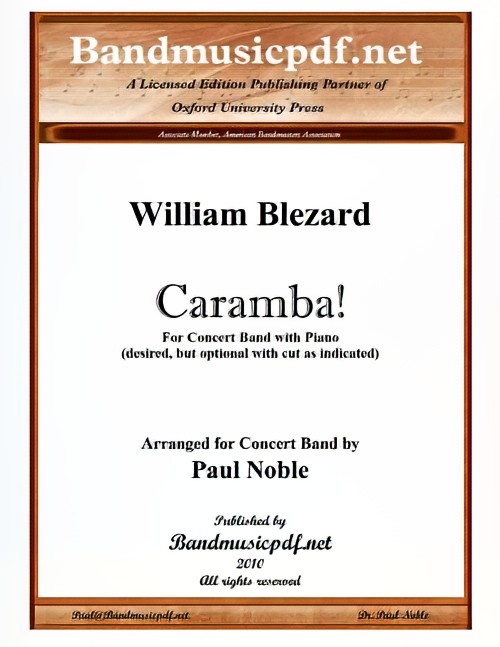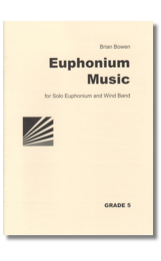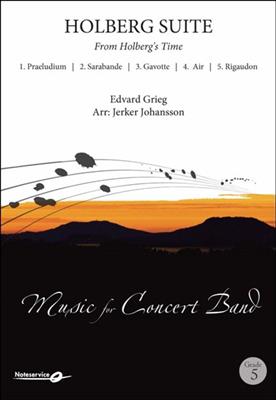Results
-
 £110.00
£110.00Caramba! (Concert Band - Score and Parts) - Blezard, William - Noble, Paul
William Blezard began writing Caramba! during a tour of New Zealand. Yet the musical basis of this work is about as far away from Kiwi culture as one can get. The word Caramba has several translations from the Spanish, including Dear Me!, or Goodness Me!, or perhaps more colloquially, Golly, or even Holy cow!. The entire work has an exotic feel to it that is so suggestive of things Spanish or Latin American. This is helped by the extensive use of percussion, and of course the brass is pure Latin American dance style. The demanding piano part is featured as almost a 'concertante'. In the Concert Band arrangement, the piano is highly desirable to replicate the original score, but the arrangement includes enough doubling and a short cut to make the piece entirely playable without the piano. Caramba! has all the hallmarks of a great piece of concert music that pleases as well as excites. For bands that want a challenge that is sure to bring an audience to its feet, Caramba! is the piece!
Estimated dispatch 7-14 working days
-
£29.95
Waltz in A Flat - Score and Parts - Johannes Brahms
Program NotesJohannes Brahms was born in Hamburg in 1833 but spent much of his working life in Vienna, where he was one of the leading figures in what is generally known as the Romantic period. Such was his significance that he is often referred to as one of the "Three Bs" alongside Bach and Beethoven! His compositions range from piano solos to major works for choir and orchestra and, as a virtuoso pianist, premiered many of his own works. His beautiful Waltz in A-flat Major is an item of repertoire that is familiar to many - even if it's not known by name! Published as one of a set of 16 waltzes for piano (Opus 39:15), it has been transcribed here for wind band by Brian Bowen.
Estimated dispatch 7-14 working days
-
£5.95
Waltz in A Flat - Score only - Johannes Brahms
Program NotesJohannes Brahms was born in Hamburg in 1833 but spent much of his working life in Vienna, where he was one of the leading figures in what is generally known as the Romantic period. Such was his significance that he is often referred to as one of the "Three Bs" alongside Bach and Beethoven! His compositions range from piano solos to major works for choir and orchestra and, as a virtuoso pianist, premiered many of his own works. His beautiful Waltz in A-flat Major is an item of repertoire that is familiar to many - even if it's not known by name! Published as one of a set of 16 waltzes for piano (Opus 39:15), it has been transcribed here for wind band by Brian Bowen.
Estimated dispatch 7-14 working days
-
 £37.76
£37.76Simply Carols - 45 Favourite Christmas Carols - Wind Band Set
VIEW SCORE PDF This resource features 45 Favourite Christmas Carols aimed at Intermediate Ensemble and above. All arranged by Kevin Larsson, who has over 20 years' experience working with youth ensembles, they are designed to be flexible and playable by a wide range of different groups, including brass, winds and strings. The arrangements use limited ranges, keys and rhythms and fingerings and slide positions are included for accidentals on the brass parts. PDF parts come in both march card an A4 size. Scored for quartet, the arrangements will work just as well with larger groups. Promotional videos for this product can be viewed at: www.youtube.com/watch?v=dTwB-Zy-c08 (short version) www.youtube.com/watch?v=g4IsIM8x7NU (extended version) The sheet music for this is available from Solid Brass Music Company at www.solidbrassmusic.com where parts, score and piano reduction can be purchased individually. Included in Wind Band Set: Full Score1st Part Bb1st Part C1st Part Eb2nd Part Bb 2nd Part C2nd Part Eb2nd Part F3rd Part Baritone Bass Clef3rd Part Eb3rd Part F3rd Part Trombone Bass Clef4th Part Bass Clef 4th Part BbPercussion (optional) Full Set available at www.brookwrightmusic.com/product-page/simply-carols-45-favourite-christmas-carols-for-intermediate-ensemble and includes Piano Reduction Brass Band Set available at www.brookwrightmusic.com/product-page/simply-carols-45-favourite-christmas-carols-brass-band-set Full Score available at www.brookwrightmusic.com/product-page/simply-carols-45-favourite-christmas-carols-full-score
In stock: Estimated dispatch 1-3 days
-
 £90.00
£90.00Euphonium Music - Brian Bowen
Something of a classic in its brass band and piano versions! We are delighted, at last, to make this work available ith wind band accompaniment by the composer. Written in 1978, the work is constructed in three movements and is virtually a concerto for euphonium and band. The first movement begins with an unaccompanied motto theme, which uses all twelve notes of the scale but with a tonal feel. The slow second movement is based on an original song melody by the composer - 'The Eyes of God' - and affords lyrical and richly expressive playing that is typically euphonium. Movement three follows without a break - a capricious movement which ends triumphantly. Now available in versions for piano, brass band, wind band, and orchestra, Euphonium Music can be seen as a major contribution to the literature for the instrument. Duration: 15 minutes USA Grade 5 An orchestral version is available on hire.
Estimated dispatch 7-14 working days
-
 £139.99
£139.99Quadrille - Anton Bruckner
In September 2024, we celebrate the 200th birthday of the Upper Austrian composer and organist Anton Bruckner. Many of his well-known works have already been arranged for wind orchestras, but the Quadrille, originally composed for piano for four hands, is still missing in the repertoire. This arrangement by Andreas Ziegelbck aims to fill that gap, staying closer to the original piano version. While the six movements of the piece can be seen as standalone short pieces, it is recommended to perform all movements. This arrangement expands Anton Bruckner's repertoire for wind orchestras with a rarely played musical gem.
Estimated dispatch 7-14 working days
-
 £149.40
£149.40Bekken (Fra Lyriske stykker opus 62) - Edvard Grieg
Brooklet is one of the movements from Grieg's Lyric Pieces for Solo Piano opus 62. Information for the conductor: Brooklet is an technically advanced work for solo piano. In this arrangement, technical passages are simplified by overlapping and doubling some of the parts. To master the technical challenges and make it sound effortless, it is important to pay close attention to balance and precision. Some of the parts also have alternative parts added which can lower the technical challenges a bit. The normal instrumentation are Clarinet 1-2-3, but there is also an "optional" part for Solo Clarinet. This is included on the same sheet as Clarinet 1. Both parts can stand alone or be played together. (i.e. The Solo Clarinet part can be played in addition to Clarinet 1, in whole or in part if desired, or it can replace Clarinet 1 entirely, using only Solo Clarinet and Clarinet 2 and 3.). From bar 5 to bar 13, there is a suggested solo for Solo Clarinet. If played by Solo Clarinet, please omit Clarinet 1, 2 & 3 for these bars.
Estimated dispatch 7-14 working days
-
 £47.50
£47.50The Fox - Béla Bartók
One of the numerous short piano pieces for children that Bla Bartk completed in a four-volume piano collection in 1909. This arrangement for early band students remains faithful to Bartk's intent while comfortably accommodating the skills for first year players. Light and whimsical, you can hear the playful nature of The Fox in this solid scoring for your beginners. (1:45)
Estimated dispatch 7-14 working days
-
 £252.10
£252.10Holberg Suite - Edvard Grieg
Edvard Hagerup Grieg (1843-1907) was a Norwegian composer and pianist. He is widely considered one of the leading Romantic era composers, and his music is part of the standard classical repertoire worldwide. His use and development of Norwegian folkmusic in his own compositions put the music of Norway in the international spectrum, as well as helping to develop a national identity. Grieg is regarded as simultaneously nationalistic and cosmopolitan in his orientation, for although born in Bergenand buried there, he traveled widely throughout Europe, and considered his music to express both the beauty of Norwegian rural life and the culture of Europe as awhole.1884 was the bicentenary year of the birth of Ludvig Holberg (1684-1754)and as a part of the celebrations various Scandinavian composers were commissioned to write commemorative pieces. From Holbergs Time was one of Griegs contributions. It was first written for piano but in 1885 the composer transcribed it for stringorchestra. For his suite Grieg went back to some of the musical forms used by Holbergs contemporaries but although the forms and style may be rococo the contents are unmistakably characteristic of Grieg himself. Grieg gave the first performance ofthe piano version in Bergen, Holbergs birthplace, in December 1884.
Estimated dispatch 7-14 working days
-
 £54.99
£54.99Spinning Song
A delightful arrangement of one of the most popular piano teaching pieces of all time. It makes a unique band piece and your audience members will remember it from their days of piano lessons. Delicate syncopation and distinctive harmonic content make this a wonderful teaching tool and an outstanding choice for any concert or contest performance. Very highly recommended!
Estimated dispatch 7-14 working days
